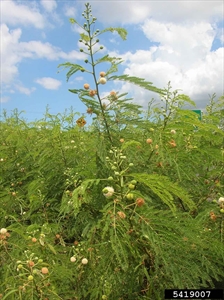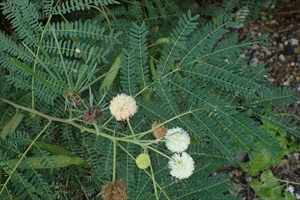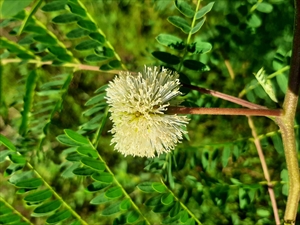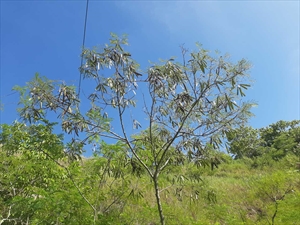Leucaena. It is also known as coffee bush, hedge acacia, horse tamarind, wild tamarind, white leadtree.
Pacific Pests, Pathogens and Weeds - Online edition
Pacific Pests, Pathogens & Weeds
Leucaena (500)
Leucaena leucocephala; previously, it was known as Acacia glauca, Leucaena glauca, Mimosa leucocephala. It is a member of the Fabaceae. There are three subspecies: i.e., leucocephala (Common or Hawai'ian type), glabrata (Giant or Salvador type), and ixtahuacana, a relatively new find.
Asia, Africa, North, South and Central America, the Caribbean, Europe, Oceania. It is recorded from Australia, American Samoa, Cook Islands, Federated States of Micronesia, Fiji, French Polynesia, Guam, Kiribati, Marshall Islands, Nauru, New Caledonia, Niue, Northern Mariana Islands, Palau, Papua New Guinea, Samoa, Solomon Islands, Tokelau, Tonga, Tuvalu, Vanuatu, and Wallis and Futuna. It is native to Mexico and Central America.
An aggressive invasive tree of disturbed sites especially on calcareous soils (Photo 1). It has a number of characteristics that assist weediness, and affects management: it flowers and fruits in the first year, and all-year round, is self-fertile, produces abundant seed, has a hard seed coat (seed remains alive and germinates over a long period), creates large seed banks, seeds are readily dispersed, and trees resprout after fire or from cuttings. Leucaena forms dense thickets, and spreads rapidly in pastures (where it is often established as a fodder tree), along roadsides, open woodlands, parks, gardens, wastelands, riverbanks and coastal foreshores. From sea level to 800 masl.
Shrub or small tree growing up to 10 m (Photo 2). Leaves alternate along the stems, bipinnate, i.e., they divide into 4-9 pairs of leaflets, up to 10 cm long, dividing again into about 12 pairs of smaller leaflets, 9-12 mm long, opposite along a central stem, and greyish-green. Flowers on young shoots, developing at the same time as the leaves, in round clusters (100-200 flowers), on stalks, 5-6 cm long (Photos 3-5). Individually flowers are white to cream, with long stamens, up to 10mm (Photo 6). Fruits pods up to 15 cm long in clusters, with about 20 flat brown seeds in each (Photos 7&8). Trees have tap roots several metres long.
Spread by seed, dispersed by rodents and birds, and by cattle after passing through their intestines. Also by machinery and vehicles.
Introduced into most Pacific island countries, and in some, for instance, Tonga and Vanuatu, it is a serious problem. It forms dense thickets, preventing movement of animals, and shades out other plants, negatively affecting biodiversity.
The impact of leucaena is complex. There are two main subspecies, leucocephala and glabrata, both present in many countries. Subspecies leucocephala, used for fodder, fuel, shade and green manure for decades, is now recognised as a weedy shrub threatening native species, and should be controlled. By contrast, subspecies glabrata, a larger tree, is recognised for its potential in tree/forage systems for cattle production, and as a shade tree for several plantation crops, and is valued by farmers (e.g., Australia). Unfortunately, this species, too, shows a tendency to 'weediness'. Whereas there is community concern to see better management of all leucaena - as most people cannot tell the subspecies apart - farmers would like to continue to use subspecies glabrata and develop sterile lines to reduce invasive potential.
Used throughout the world as a shade for coffee, cocoa, vanilla, and as a fodder crop for cattle in leucaena/grass systems. There are also minor uses as firewood, stakes, a human food (pods in salads), a nurse crop for native forest species, to stabalise soil (introduced in many Pacific countries after WWII to rehabilitate areas), and to restore fertility because of nitrogen-fixing ability. It is used in alley cropping systems, although it is known to have allelopathic effects on neighbouring crops. There are medicinal uses recorded, too, e.g., for the control of internal parasites, and pains.
Note, K8 released by the University of Hawaii and common in the Pacific islands is a 'Giant' type, as is K67 another popular variety. Hybrids between 'Giant' and 'Peru' types have been bred in Australia as large, branching fodder trees, e.g., cultivar Cunningham. These varieties have also been widely used in reforestation.
BIOSECURITY
Countries where leuceana is not yet introduced should consider all likely pathways for entry, and apply quarantine measures accordingly. Particular attention should be given to the difficulty of controlling this tree once it has become invasive, and that seeds are available for purchase on the Internet.
Leucaena leucocepala is on the Global Invasive Species Database (2021) of information on alien and invasive species that negatively impact biodiversity, managed by the Invasive Species Specialist Group of the IUCN Species Survival Commission: http://www.iucngisd.org/gisd/species.php?sc=23. It is also among 100 of the World's Worst Invasive Alien Species on the Global Invasive Species Database, maintained by the IUCN Invasive Species Specialist Group, 2021: http://www.iucngisd.org/gisd/100_worst.php.
BIOLOGICAL CONTROL
The bruchid beetle, Acanthoscelides macrophthalmus, a seed predator from Central and South America has been released in South Africa. In Australia, where it was accidentally introduced, it is found wherever leucaena occurs, but its impact is not well recorded.
Heteropsylla cubana, a psyllid causing leaf loss and dieback, occurred for the first time in Oceania in the mid-1980s. In most Pacific island countries, control was short-lived with natural enemies of the psyllid bringing it rapidly under control, although in coastal Queensland, where leucaena is planted as cattle fodder, the psyllid remains damaging, and resistant varieties are being sought.
CULTURAL CONTROL
- Physical & Mechanical:
- Hand-pulling is possible for small infestations, as long as the long tap roots are also removed and disposed of appropriately, otherwise they will regrow.
- Slash infestations - same conditions as for hand-weeding. Treat stumps and collect cuttings to prevent regrowth.
- Livestock.
- Use cattle or goats to graze trees. However, leucaena grows rapidly and becomes out of reach. (Stomach problems from cattle overeating leaves is solved, e.g., in Australia, by introduction of a stomach bacterium).
- Hygiene:
- Treat vehicles and farm machinery. If moving from areas where the weed occurs to those weed-free, wash to remove soil. This is equally important if the machinery is being imported into a country or moved within a country.
CHEMICAL CONTROL
In Australia, minor use permits allow the use of: triclopyr + picloram; and triclopyr + picloram + aminopyralid. There are two methods of application: foliar spray (for seedlings and stems <5 cm diameter) or cut-stump (cut stem just above ground level and paint immediately with undiluted herbicide). 2,4-D in diesel also used as a basal bark treatment.
____________________
When using a pesticide, always wear protective clothing and follow the instructions on the product label, such as dosage, timing of application, and pre-harvest interval. Recommendations will vary with the crop and system of cultivation. Expert advice on the most appropriate herbicides to use should always be sought from local agricultural authorities.
AUTHOR Grahame Jackson & Mani Mua
Information from PIER (2017) Leucaena leucocephala (Lam.) de Wit, Fabaceae. Pacific Island Ecosystems at Risk (PIER), Institute of Pacific Islands Forestry. (http://www.hear.org/pier/species/leucaena_leucocephala.htm); and CABI (2019) Leucaena leucocephala (leucaena). Invasive Species Compendium. (https://www.cabi.org/isc/datasheet/31634); and DAF (2020) Leucaena Leucaena leucocephala. Queensland Government. (https://www.daf.qld.gov.au/__data/assets/pdf_file/0019/73450/leucaena.pdf). Photo 1 Dan Clark USDI National Park Service, Bugwood.org. Photo 2. Forrest & Kim Starr, Starr Environmental, Bugwood.org. Photos 4&5 Gerald McCormack Cook Islands Biodiversity & Natural Heritage. Photo 7 Krish Dulal Pods of Leucaena leucocephala in the month of May: (https://commons.wikimedia.org/wiki/File:Leucaena_leucocephala_NP.JPG).
Produced with support from the Australian Centre for International Agricultural Research under project HORT/2016/185: Responding to emerging pest and disease threats to horticulture in the Pacific islands, implemented by the University of Queensland and the Secretariat of the Pacific Community.











